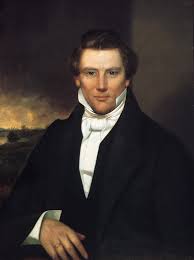 I was ill earlier this week, so took the opportunity to listen to the Priesthood Session of General Conference. I was particularly heartened by Elder Anderson’s confident advice to “give Brother Joseph a break.”
I was ill earlier this week, so took the opportunity to listen to the Priesthood Session of General Conference. I was particularly heartened by Elder Anderson’s confident advice to “give Brother Joseph a break.”
The theme of the Conference was a call to believe, with many suggestions on how belief could be strengthened. For some, however, it helps to quiet the mocking voices in their heads to provide a plausible alternative to the popular bogeyman of the non-believers, the Joseph as narcissistic imposter who allegedly made up scripture from whole cloth and took dozens of his followers’ daughters and wives to his bed.
First, A Picture
 In 1969 a family donated a daguerreotype to the RLDS Church (now the Community of Christ). They claimed it was a picture of Joseph Smith. If it is Joseph, the youth and gaunt look of the man in the image indicate the photo was taken in late 1839. In November-December 1839 Joseph took a trip to Washington D.C. to seek redress for the atrocities perpetuated against the Mormons in Missouri. Due to Joseph’s notoriety, it is reasonable an early daguerreotypist in DC would have sought to capture his likeness.
In 1969 a family donated a daguerreotype to the RLDS Church (now the Community of Christ). They claimed it was a picture of Joseph Smith. If it is Joseph, the youth and gaunt look of the man in the image indicate the photo was taken in late 1839. In November-December 1839 Joseph took a trip to Washington D.C. to seek redress for the atrocities perpetuated against the Mormons in Missouri. Due to Joseph’s notoriety, it is reasonable an early daguerreotypist in DC would have sought to capture his likeness.
Rick Brunson has a brief article on his blog describing the evidences Shannon Michael Tracy documents in his book, Millions Shall Know Brother Joseph Again. In summary, this daguerreotype allegedly matches the death mask using both lineal matching and facial recognition techniques. The image also corresponds with photos taken of Joseph’s skull prior to the remains being reinterred during the early 1900s.
[Updated 10/11/15: There was apparently a storm of controversy about this image and the Tracy book in 2008. One disappointed summary can be found at Juvenile Instructor. When I scanned that article, it appears the author went from hoping this was an image of Joseph Smith to being completely angered by the unprofessionalism of Mr. Tracy. In my reading of this summary, I missed whether the picture had been proven to be not of Joseph. For the record, I was intrigued by seeing this image illustrating a post from a reputable blogger, with the text indicating that they hoped this was an actual image of Joseph Smith. Searching things more, I happened upon the Brunson blog.]
Having reviewed the comparison of the photograph to the Joseph’s death mask and skull, I can see how the famous painting (top) could have been made of an older version of the man in the photographic image. I can also see why Joseph would have said the painting made him look sissified. The narrowness of the painted nose and the pointed chin are similar to the photograph, but idealized in a way I could imagine Joseph considering sissified.
To review how painted portraits and photographs of subjects might vary, we can look at the images of Joseph’s wife, Emma Hale [Smith Bidamon], from the 1840s:
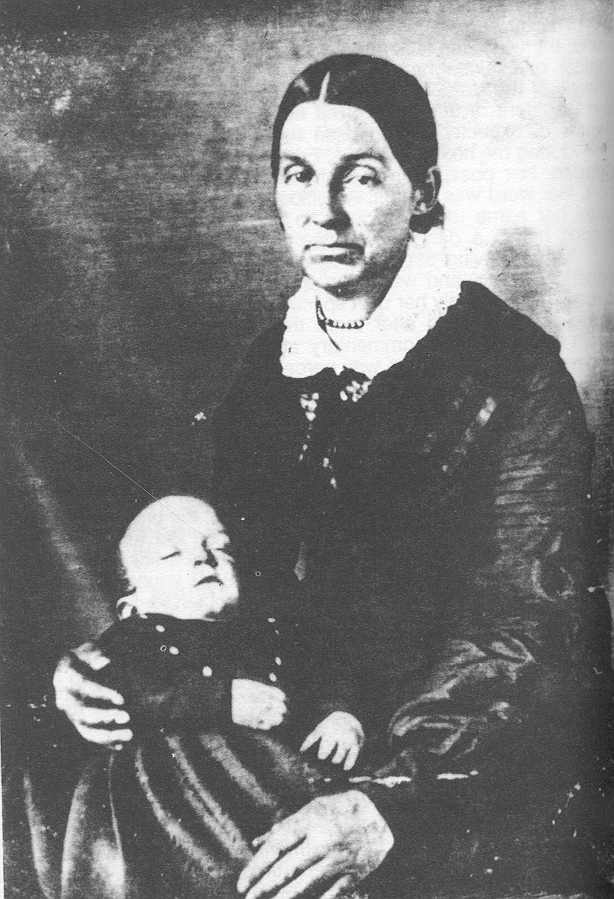 In the daguerreotype of Emma, she is shown with her son, David Smith, born a few months after Joseph’s death. She is in mourning black, but has a lace collar as well as the necklace of gold beads Joseph presented to her.
In the daguerreotype of Emma, she is shown with her son, David Smith, born a few months after Joseph’s death. She is in mourning black, but has a lace collar as well as the necklace of gold beads Joseph presented to her.
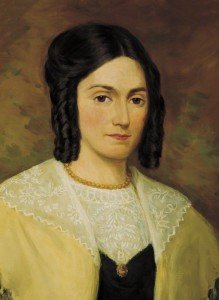 In the painting, Emma would have been a few years younger. Emma is shown with her characteristic shiny black hair parted in the middle. Again we see the gold bead necklace and the lace. As for the ringlets, Emma’s great-great grand-daughter tells me these were clip-ons. Perhaps Emma felt such things would be frivolous for her to wear for the daguerreotype, when she was a mourning widow.
In the painting, Emma would have been a few years younger. Emma is shown with her characteristic shiny black hair parted in the middle. Again we see the gold bead necklace and the lace. As for the ringlets, Emma’s great-great grand-daughter tells me these were clip-ons. Perhaps Emma felt such things would be frivolous for her to wear for the daguerreotype, when she was a mourning widow.
Another interesting comparison is to look at the similarity of the daguerreotype image to known pictures of Joseph’s sons and notable blood kin.
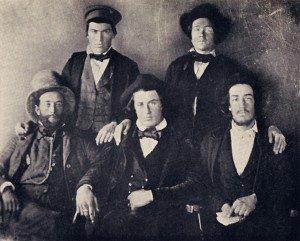 An image of Joseph’s sons and their step-father, Lewis Bidamon, was taken around 1859. Joseph Smith III, with the beard and long face, would have been about 26. The youngest, David, would have been 14 or 15.
An image of Joseph’s sons and their step-father, Lewis Bidamon, was taken around 1859. Joseph Smith III, with the beard and long face, would have been about 26. The youngest, David, would have been 14 or 15.
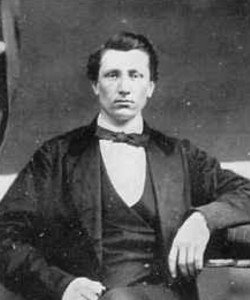 Joseph F. Smith was the son of Joseph’s brother, Hyrum. Thus he was Joseph Smith’s nephew. We are more familiar with older pictures of him.
Joseph F. Smith was the son of Joseph’s brother, Hyrum. Thus he was Joseph Smith’s nephew. We are more familiar with older pictures of him.
Joseph F. Smith’s pose and the position of his hand appear to be modeled on the famous painting of Joseph Smith.

Joseph Fielding Smith, shown here at age 33 when he was called as an LDS apostle, is son of Joseph F. Smith and therefore Joseph Smith’s great-nephew.
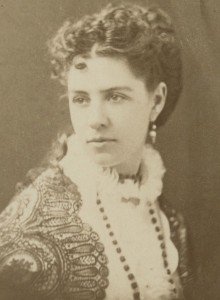
Ina Coolbrith, the famed California poet, was Joseph’s niece. This image of her was taken in about 1870, when she was around 30 years old.
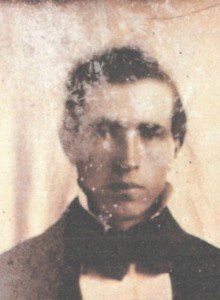
Looking again at this early daguerreotype, it is clear that the man in this image has similar facial features to Joseph Smith’s blood kin.
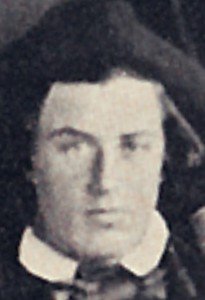
Reviewing a flipped image of Joseph’s son, Alex, the similarity is particularly striking. Note the hairline and the arched brow on the shadow side of the image. Alex would have been about 21 at the time of this picture, while his father (if it is Joseph) would have been 33.
[Updated 10/11/15: Despite all this fun looking at pictures, it would require more than this to “prove” the image was of Joseph Smith. I am reminded of the time we realized my great-great-great aunt (Phoebe Holmes [Welling]) looks like my husband in drag. Much hilarity ensued. And yet there is no blood relationship between Phoebe Holmes and my husband.]
What Bothers Those Tottering on the Brink of Disbelief?
A few years ago, John Dehlin made much about the various reasons people give for losing their testimonies. I responded to several of these reasons in my open letter to John after his excommunication, To My Dear Friend, John Dehlin.
However Elder Anderson did not say “Give the Church a break.” He said, “Give Brother Joseph a break.”
I’ll infer from Elder Anderson’s words that he has heard much angst from people who find that Joseph Smith (based on information from media outlets and the internet) is not the monogamist and scholar they previously imagined him to be.[ref]Independent of Elder Anderson’s comment, I am personally aware of many who report their friends and acquaintances have been terribly torn by the recent assertion regarding Joseph’s extensive list of “wives.”[/ref]
Not a Scholar?
You don’t have to dig far into Mormon lore to remember that Joseph was a country boy with initially a grade-school education. My favorite was Joseph breaking off from dictating the Book of Mormon and asking Emma if there was a wall around Jerusalem (likely when dictating 1 Nephi 4:5). As Emma would later relate, the Book of Mormon had to be of divine origin, for it was a certainty that Joseph Smith was incapable of generating such a manuscript without divine help.
Joseph would use the term “translate” to describe what he did in bringing forth the Book of Mormon, the changes he was inspired to make to the Bible, and the source of the Book of Abraham, inspired by papyri accompanying mummies Joseph purchased in the mid 1830s. Yet there is no contemporary description that aligns with what moderns think of when they say “translate.”
Joseph was not usually looking at the original document. In fact, it was common for him to utilize a seer stone or the Urim and Thummim in “translation” and revelation, as discussed in the excellent article Joseph, the Seer in the October 2015 Ensign. His use of the stones was so well-know that he was urged to use the Urim and Thummim when writing the revelation on the New and Everlasting Covenant in July 1843 (a suggestion that he declined to follow, saying he knew this revelation without needed to resort to the interpreters).
One beauty of Joseph receiving the Book of Mormon, in particular, by revelation is the possibility that God allowed the actual prophets of the Book of Mormon, along with deceased scholars familiar with the Bible, to participate in making sure Joseph “got it right.”
I’ll reiterate two points here. First is how often the prophets of the Book of Mormon expressed their concern that their written language was incapable of capturing the power of their spoken sermons. I see the power of God manifested in finding a means for their spoken words to shine through, despite the limitations of their written language.
Second is an observation from reading Professor Royal Skousen’s edition of the Book of Mormon, where he painstakingly assembles the earliest version from the manuscript (where available) and the printer’s copy. When I first read the earliest text, I thought the grammar was backwoods New York in origin. But then I learned that it was actually an earlier version of English, from before the King James Bible and Shakespeare. Specifically, it is the English spoken at the time William Tyndale first translated the Bible into English.
We Mormons are familiar with the idea of God assembling teams to perform His work, such as asking Christ and Michael to preside over creation or having John and the three Nephite apostles minister to believers.
If I were assembling a post-mortal team to help provide the most authentic version of Mormon’s condensation of the Lehite records in English, I might have paired Mormon, Moroni, Nephi, and passionate English-speaking Bible scholars, such as Tyndale.
For any who have been super sad to learn that “translation” wasn’t done like depicted in the pretty portraits of a white-blond Joseph studiously translating the golden plates in full view of all comers, I am sorry for you. There was a reason for the testimony of the three and eight witnesses. The plates were not openly displayed for others to see.[ref]Laura Hales points out that there are multiple accounts regarding a time an angel showed the plates to Mary Whitmer, to set her mind at ease regarding the great work of God taking place in her home, see the <a href=”http://www.mormoninterpreter.com/another-account-of-mary-whitmers-viewing-of-the-golden-plates/”>2014 Interpreter article by Royal Skousen</a>.[/ref] Emma and other family members handled them through the cloth in which they were wrapped, so it’s more than the testimony of those twelve (Joseph and the 11 (3+8) witnesses) that leads us to know there was a physical artifact. Those pretty pictures that previously informed your imagination were painted by good people in a polite culture, where those who knew the historical stories of the translation process were too kind and loving to screech, “That painting is completely wrong. That never happened that way! Take it away, burn it up! Back to harvesting crops for you!!”
[For what it’s worth, people in my particular household are not always polite, kind, and loving. We would have been rather up front in telling those artists where they’d gotten it wrong…]
Once you give up on the fantastical and fictional version of “translation” depicted in these paintings, you can find the power and beauty in the actual process.
As for modern scholars of Egyptology, Joseph produced his translation before widespread understanding of the Rosetta stone, so modern Egyptology has formed in the context of Joseph’s claims. Anyone attempting to publish or teach anything that might resemble what Joseph said would have been mocked and ridiculed. This phenomenon is known to happen among anthropologists, who will give no concessions that might substantiate Mormon stories regarding early American inhabitants. Thus the academic fields have already reacted to Joseph, with an unabashed refusal to support his assertions. It should be no surprise, then, that “scholars” do not agree with certain Book of Mormon or Book of Abraham implications.
But What About all Those Wives?
Since 2007 I have increasingly been of the opinion that there was little, if any, sexual component to the relationships between Joseph Smith and his covenant wives (other than Emma Hale [Smith]).
From the time I was a teenager, I had been painfully aware of Joseph’s many marriages, which until 2007 I presumed had involved normal marital sexual relations.
As I recall, the first data point that challenged my presumption of full sexuality was a summary of the DNA investigations conducted by Ugo Perego, summarized at the website Wives of Joseph Smith. I have since read Ugo Perego’s paper on the subject, published in The Persistence of Polygamy, Vol. 1. No DNA evidence confirms Joseph as the father of children borne to the women with whom he covenanted. Only in the case of Josephine Lyon [Fisher] is there any uncertainty, and Dr. Perego is raising funds to repeat the testing using more sophisticated techniques (the original samples now being the property of some corporation that doesn’t want to share).
Next, I realized that the reproductive history of my ancestor, Elvira Annie Cowles [Holmes Smith], was odd. Elvira was the Smith governess and one who had covenanted with Joseph. Sister Elvira, as she would have been known, remained childless until the year after Joseph’s death, conceiving no earlier than February 1845 (Joseph died June 1844). When Elvira covenanted with Joseph, she had recently been married (by Joseph) to the widower Jonathan Holmes. Family tradition (and lore submitted by family friends (the Wrights) to LDS Church headquarters in the early 1900s) indicates that Jonathan explained Elvira had been Joseph’s wife, that he had not become her husband until after Joseph’s death. Jonathan was legally Elvira’s husband prior to Joseph’s death, leaving the possibility that Jonathan was talking not about the wedding, but the consummation of the marriage.
The odd thing was that once Elvira started having kids, she proceeded to have kids every two years until she passed the age of 43.
As I reviewed the history of the other women who apparently covenanted with Joseph prior to his death,[ref]There were many women who were never associated with Joseph in life who wanted to be sealed to him when the Nauvoo temple was operating. It was a time when the customs regarding marriage (or sealing) in the New and Everlasting Covenant were not yet mature. People wished to be sealed but didn’t understand that sealings were expected to unite them to their own families, regarding both marital relationships and parent-child relationships. The final clarification of the proper order of such things was not laid out until the 1890s, when explained in those terms by President Wilford Woodruff.[/ref] I began to suspect that the big secret was that Joseph wasn’t having sex with any of them, as I commented to Jan Shipps in 2009.
It is impossible to prove that no sex was going on, but we have these factors:
1) No otherwise single “wives” bore children that could have been conceived during Joseph’s lifetime.[ref]Brian Hales argues Olive Frost bore Joseph’s child, but Olive and her child died in October 1845 with no age or birth date recorded for the infant. The report that the child was “Joseph’s” cannot exclude the possibility that the relationship was reported based on Olive’s covenant with Joseph. Brigham Young married Olive after Joseph’s death and I assert it is more likely he engendered the child that was buried with Olive in October 1845.[/ref],[ref]The death record for the child of Lucy Walker [Smith Kimball] is ambiguous. Birth date is give as January 1845, which would place conception before Joseph’s death. However the age of the child at death is given as 17 months, indicating birth occurred in January 1846. It appears more likely that the year of birth was written incorrectly (1845 rather than 1846) for a child born at the cusp of a year than that the age at death was incorrectly recorded as 17 months rather than 29 months.[/ref]
2) None of the children of “wives” with legal husbands can be shown to have been engendered by Joseph Smith.[ref]Brian Hales and others are enamored of the idea that Josephine Lyon was Joseph’s biological child, based on the deathbed testimony of Sylvia Sessions [Lyon Smith Clark]. Yet Sylvia’s deathbed confidence to Josephine (see http://josephsmithspolygamy.org/history-2/plural-wives-overview/sylvia-sessions/) was recorded by a third party (Andrew Jenson) decades after Sylvia’s death. Even the third-hand record of the confidence does not specify that Josephine was Joseph’s biological daughter. Josephine initially married outside the Church (temple marriages being when information about a mother’s sealing to Joseph Smith would have typically have been conveyed), so there was a reason Sylvia would have felt in necessary to confide in Josephine where there is no record of a similar confidence shared with Sylvia’s children by Ezekiel Clark (none of Josephine’s Lyon siblings survived to adulthood).[/ref]
3) Objective study of Nauvoo reveals that there was a great deal of inappropriate sexual behavior going on during 1841-1842. This type of “polygamy” was sometimes termed illicit intercourse and other times termed spiritual wifery. The women involved in illicit intercourse would sometimes yield to more than one man. In the well-documented case of Catherine Laur [Fuller Warren], the illicit liaisons began before July 1841 when John C. Bennett persuaded Catherine to let him bed her. She allowed six men to bed her a total of nearly two dozen times before April 1842. In April, Catherine refused to have any part with her former seducers when Joseph and Emma Smith together began openly preaching against illicit intercourse. In late April, 1842, Catherine became the legal wife of William Warren after refusing offers from Chauncy Higbee and William Smith[ref]Joseph’s brother and a sitting apostle.[/ref] to be their secret spiritual wife.
4) Examination of contemporary documents and later reminiscences of Nauvoo indicate the possibility that the earliest “plural wives” may have been either involved in illicit intercourse or involved in investigating the corruption. Many of these women were new converts from England or widows/fatherless/abandoned: in short, women in need. In several cases the men pressuring the women to yield to them were offering food and other minor protections. It appears this may have even played into how righteous men and women were convinced that spiritual wifery wasn’t just about illicit sex.
The men also assured the women that Dr. Bennett knew how to avoid pregnancy, with contemporary testimony from Mary Clift specifically mentioning the medicine her seducer gave her to prevent conception.[ref]This medicine was likely derived from Queen Anne’s lace. The seed pods are plentiful in the eastern United States throughout the summer and fall and modern naturopaths report that they have successfully avoided pregnancy while ingesting these seeds.[/ref]
Summary
If you have been significantly distressed by the difference between the Joseph Smith you thought you knew and Joseph Smith as currently portrayed by media and the internet, there are two factors:
1) You believed a caricature of Joseph, derived from paintings and assurances from those who conveyed more certainty than they actually possessed, necessarily true if they were telling you false things, such as asserting that Joseph did not covenant with women other than Emma.
2) You have been misinformed about Joseph’s history. In particular, those telling you about Joseph’s alleged depravity have not been careful to tease apart the story of Nauvoo, lumping it all into a mass of sexual weirdness they have wholly attributed to Joseph Smith’s actions and teachings.
There was a reason those who lived through the terrible mistakes of Nauvoo failed to leave detailed records of their involvement and repentance, or detailed records of those they loved who had fallen. But enough historical residue remains to construct a partial picture. From this partial picture, I find that Joseph Smith was not merely the good man we have long believed him to be, but a man of courage and compassion beyond what we ever imagined in our public past.


New Post: Give Joseph Smith a Break: I was ill earlier this week, so took the opportunity to list… http://t.co/YcC5FLtCWg #LDS #Mormon
RT @Millennialstar: New Post: Give Joseph Smith a Break: I was ill earlier this week, so took the opportunity to list… http://t.co/YcC5FL…
TheMillennialStar: Give Joseph Smith a Break http://t.co/qVnt8vL9Jp #lds #mormon
Meg, this is awesome. I love your summary. This is exactly how I have felt about Brother Joseph for many years now, and the more I study him the more sure I am that he was a prophet of God. Thanks for this post.
In a podcast from the Bill Reel site he was interviewed by 2 atheists with their own radio/podcast program. Of course, Brother Reel was being careful to openly list all of Joseph’s faults until his hosts stopped him. They were acquainted with all that. The gist of what they then said is this: compared to the other prophets and apostles of the Old and New Testaments, Joseph Smith ranks high on the list of the best-behaved.
When I was a kid still in Primary I overheard two old High Priests (at the time I thought they were the original pioneers) who agreed that Joseph was one of the lesser prophets because his behavior, on a personal level, was not up to that of the ancients. I just registered it in my mind without any emotion, as I was young at the time. However, in looking back on it I have for decades been left to wonder if they had actually read the Bible. I agree with the atheists. Upon reading the Old and New Testaments (the OT while still in Primary) I couldn’t help but conclude that God allows a pretty wide latitude of behavior in his prophets, although he doesn’t necessarily condone everything they do.
I gave a class to my 14-15 year old students on what are realistic expectations of our prophets. For a student handout, I cut and pasted pages of the D&C of God not condoning the behavior of Joseph, but still accepting him as His prophet. Ultimately, I didn’t give it out as it was just too much material (plus I was wrestling with the mandate that my function as a teacher is to support prophets as prophets and not as men). However, we did do a close comparison of behaviors of Moses and Joseph Smith.
If I ever learn that Joseph killed a Canadian with whom he had a disagreement, cover his body in the mud, and then flee to Harmony only upon realizing he might have his act discovered…then maybe I’ll rethink things…but it will not affect my conviction, which is separate from what I think. I rejoice in Joseph’s humanity, and in that of all Prophets and Apostles, ancient and modern. I especially don’t care what they were involved in before they became Prophets and Apostles and how it effected them even after their conversion as they gradually put off the natural man, or natural woman, in a process similar for everyone. I want God to give me the same degree of leeway and patience as He did with His Prophets.
I understand that Brigham Young took advantage of many things, as did others. I am still against many things he did, but I love the Church. I only obey what Joseph said & did. He was a good man & did what God told him. He married women to protect them, but was also faithful to Emma. I have always in my heart felt that he never committed adultery. The others will be judged by God. I cannot. This was in the past, so everyone can think what they want. Joseph restored Christ’s Church etc. & I thank him for it all.
[Meg: Edited to change capitalization from all caps to sentence capitalization.]
In regards to giving “Joseph Smith a break,” do we need to do that? Well, I don’t know, I think we need to read the scriptures closely, ALL OF THEM. Upon doing so, it doesn’t take long to see that we ought to give a break to just about all the prophets. Perhaps Joseph warrants less of a “break” than most.
I also love the Prophet Joseph Smith, and have a strong testimony that he was a prophet of God. I have gained a witness through prayer and.study that D&C 132 and the institution of Polygamy were inspired by God for the saints of the time.
One thing that strikes me is how much the testimony of those sealed to Joseph Smith differs from those child brides sealed to men in the FLDS Church of Warren Jeffs. None of those sealed to Joseph spoke of coercion or physical abuse. Many wrote about their personal struggle to gain a witness of the principle, but the number of women who gained such a witness is striking. I see in Joseph a reluctant polygamist prophet striving to live up to the commandments of God, no matter how difficult.
Hi Stephen,
For those who believe the assertion that Joseph was a libidinous sexual predator, they do need to give Joseph a break. Similarly, for those who think Joseph was a malicious deceiver, they need to give Joseph a break.
To any who believe Joseph was fully sexual with the women he covenanted with, please tell me what data (not the decades of supposition) cause you to believe this. If you think it is perfectly OK for Joseph to have taken dozens of women to his bed without specific authorization from God, then I think you and I need to have a discussion about why this is a damaging perception in the modern lives of Mormon adherents and non-Mormons who attempt to understand the faith.
All very interesting. The average active member of the Church who does not read Millennial Star posts should be familiar with the Teachings of the Presidents manuals. In Joseph Smith, Chapter 46 (The Martyrdom: The Prophet Seals His Testimony with His Blood), we read: The winter and spring of 1843–44 was a time of great tension in Nauvoo, as Joseph Smith’s enemies increased their efforts to destroy him and the Church. Knowing his mortal ministry would soon come to a close, the Prophet met frequently with members of the Quorum of the Twelve Apostles to instruct them and to give them the priesthood keys necessary to govern the Church. These preparations culminated in a meeting with the Apostles and a few other close associates in March 1844. In this extraordinary council, the Prophet charged the Twelve to govern the Church after his death, explaining that he had conferred upon them all the ordinances, authority, and keys necessary to do so. “I roll the burden and responsibility of leading this church off from my shoulders on to yours,” he declared. “Now, round up your shoulders and stand under it like men; for the Lord is going to let me rest awhile.” Meg, from I have read of your research (only your posts here, I haven’t clicked on the links on Joseph and plural marriage), I can speculate that Joseph might have said something like this: “Brethren, I have explained the revelation and doctrine of plural marriage to you. As you know, I cannot bring myself to live this principle by having sexual relationships and children with the women I have been sealed to. You may continue to learn about and interpret this commandment differently. I have done everything that was humanly possible for ME to do, in MY personal circumstances, to obey Elohim and Jehovah bring to pass the immortality and eternal life of man”. Brigham Young, Heber Kimball, Parley Pratt, etc. all had sexual relations and offspring from plural wives before June 1844, didn’t they?
Thanks for this Meg, as always, very interesting. I have never really let myself be bothered by polygamy and the things that critics of Joseph Smith seem to like to harp on about. When we look at the things he did do: translate the Book of Mormon, restore the Priesthood and covenants of salvation, endure endless persecution, the other stuff does not matter. The spirit will testify strongly of these things if the person is willing to listen.
Hi Laurent,
You wrote: “Brigham Young, Heber Kimball, Parley Pratt, etc. all had sexual relations and offspring from plural wives before June 1844, didn’t they?”
No, they did not.
Of these, the only one commonly believed to have engendered offspring prior to Joseph’s death was Heber C. Kimball. Kimball’s marriage to Sarah Peak Noon is inferred from the birth of a child in the latter portion of 1842 about a year after her husband (Noon) had abandoned the family. That child died, so there is no way of confirming whether or not the child was engendered by Kimball. The fact that Sarah Peak Noon was an abandoned mother (rather than a single daughter of a respectable family) piques my suspicion that she had been a victim of the seducers, making Kimball a “pretend” husband prior to Joseph’s death.
The two who did engender children with their plural wives prior to Joseph’s death were William Clayton and Joseph Bates Noble. Each of them engendered children with their respective plural wives in April or May 1843. Of these, we know that Joseph told William Clayton he might have to excommunicate him. In the case of Joseph Bates Noble, we do know his plural wife, Sarah B. Alley, tried to keep the pregnancy a secret.
You don’t have to read all 100,000 words of the Faithful Joseph series to get a better picture of what I’m talking about. You can just scan the Faithful Joseph Digest and pay attention to a few of the posts if curious about why I assert certain things.
Renee indicated Brigham Young erred in instituting full polygamy. I don’t agree with that position. While (as a descendant of John Taylor) I am practically obligated to resent some of what Brigham did, I find that his actions related to plural marriage were reasonable and consistent with the worldview of Mormonism as taught by Joseph Smith.
I have loved the prophet Joseph and respected him since my childhood, probably because my grandmother knew that, spiritually speaking, he was her mother’s father. She was my primary caretaker from my sixth year until I became a teenager. Her attitude toward the Church, the leadership and Joseph were always positive. Like the puzzle of the various images of Joseph Smith; that known to be an actual portrait but probably idealizing his features, the profiles done by Maudsley which tended to caricature once the outline of the profile was accomplished, the putative dageurreotypes, one more likely a photo of the portrait and the other very similar but of unknown origin, ideas of the character of Joseph Smith vary widely.
It is telling that everyone who knew him closely, including his family, loved him. Like all relationships involving love, some felt betrayed and turned against him. The case of William W. Phelps is an example in which the betrayor repented and was generously forgiven. It would not be surprise me if the scene took place in the hereafter in which the Law brothers and Austin Cowles asked Joseph to forgive them for their actions that led to his death.
In any case, whatever Joseph’s character, he was a prophet of God, chosen to restore the Gospel and all its power and glory and is responsible for several precious books of Scripture.
Hi Joyce,
There are those, like you, who aren’t “bothered by polygamy and the things that critics of Joseph Smith seem to like to harp on about.”
I suggest that many women who aren’t bothered by polygamy avoid the topic while most men who aren’t bothered by polygamy either accept Joseph as a practicing polygamist under God’s command or accept Joseph as a practicing polygamist without God’s command, but having done good in other areas of his life.
I am targeting this post to those who are terribly bothered by what they think Joseph did, who need to give Joseph a break to save themselves from jettisoning the gospel in their disgust.
To these, I think a better approach (given what I believe occurred) is to expand the range of historical factors that could have resulted in the tale they have heard. I don’t think it helps this population to say, “Well, these things don’t bother me and/or the Old Testament prophets did worse things.”
“I suggest that many women who aren’t bothered by polygamy avoid the topic ”
Meg, I would put this slightly differently. I would say, “many women who aren’t bothered by polygamy have decided to either 1)accept your idea that Joseph was faithful to Emma or 2)decided to put the issue on a mental shelf until they understand it better. Later on, they may take it off the shelf to examine it, but in the meantime it is not as important as going to the temple, performing your calling, taking care of your family, etc.” There is a difference between “avoiding a topic” and “not concentrating on a topic.” My wife does not concentrate on the issue of polygamy, but she certainly does not avoid it.
Granted.
It’s just that I want people to not merely put the matter on a mental shelf, but examine the history and find the wonderful and compassion man I have come to know. Most of the comments seem to say, “Hi Meg, I’ve come to peace with a possibly polygamous Joseph who slept with young girls and other men’s wives. I may or may not have read anything you wrote but I am unable to shift my own worldview enough to argue for the wonderful Joseph you have been blogging about.”
If you, who can be bothered to read M* and comment don’t see Joseph to have been unquestionably honorable in his dealings, then what of the thousands and millions beyond the readership of this blog?
Regarding the “translation” of the Book of Mormon, I found it intriguing in my most recent read that Mormon himself referred to the process of how the Book of Mormon would be brought forth as not translation, but “interpretation.” Joseph, of course, said it was “translation” that was the process he used.
I’ve always thought of “interpretation” as a process much different than the usual thought of translation. Perhaps Joseph’s understanding of the two words was not the same as mine. Interpretation seems more fluid, more open, while translation, in my mind, tends to be a more structured process, including understanding of both languages being used. Of course, Joseph did not have any background in the Hebrew or Egyptian languages at that time in his life, so “translation” as I understand it would have been, at best, a generous understanding of the actual process.
I find it both interesting and powerful that Mormon himself was inspired to some degree as to how the record would be taken from a dead, obscure language to the most used language in the world of our day.
I eagerly anticipate the “Give Brother Brigham a Break” article.
I also liked another piece of advice from Elder Anderson: “I testify that Joseph Smith was a prophet of God. Settle this in your mind, and move forward!”
The more I read the Bible, the more I’m convinced that the manner in which God worked through Joseph Smith was the same as how He worked through Biblical prophets.
People who claim “That’s not how God works” in reference to Joseph Smith’s teachings, claims and actions (or teachings of the BoM and D&C), are showing they don’t understand or believe the God of the Bible.
As Jeff Lindsay has often pointed out in his apologetic writings, the Christian critics of Mormonism believe in a God defined by 4th century interpretations and philosophies, with a heavy Greek influence, and not the God of the Old Testament or the God of the 1st century New Testament.
Hi Meg,
To answer what I think are your inferences from my comment way back up there: I believe Joseph’s sexual practices with women were in accordance with his revelations as we currently have them. My sense is that the two atheists referred to believed that Joseph’s sexual practices were evidence of excessive libido whether within or outside the bounds of marriage. Despite that, they felt that Joseph’s behavior was still exemplary in comparison to the bulk of Biblical prophets. They were not speaking for members of the Church of any stripe. As to Bill Reel, I don’t know what he currently believes.
Hi Stephen,
One of the fun things about being a permablogger here is that I’ve put up more posts than I can easily recall off the top of my head. And I get e-mailed copies of the comments that are made on my posts. So when I’m not sure how to read something, I can do a search of my gmail to see the total past comment history of a person. And so when I wasn’t sure how to take your comment, I was able to review your past comments on my posts and remember that I like your voice.
I am glad that you believe Joseph’s actions were consistent with the revelations he was getting.
I remain frustrated that you and others continue to indicate a lack of “getting” what I am saying. I think it is huge for folks to acknowledge that Joseph was dealing with a sex scandal that threatened the entire restoration, something that makes the modern sexual abuse by Catholic priests look tame in comparison.
When I say Joseph was honorable, I am not talking about whether or not he kept his pants fastened (though I am inclined to think that he did). I am talking about the way he dealt with the corruption, healing the people over whom God had set him as steward with so few casualties. Part of that healing, ultimately, was accomplished when Joseph sacrificed his life (albeit with help from the conspiracy trying to kill him).
Because of how Joseph handled things, we were gifted with an Eliza Snow who was unimpaired in her ability to serve and bless. We were gifted with many generations who were spared the vile details of Nauvoo. Many of the men and women who had been temporarily persuaded of Bennett’s spirtual wifery heresy repented, their secrets almost entirely hidden from our view.
A challenge with not exposing/accepting the dual nature of Nauvoo polygamy (horrifically depraved as illicit intercourse/spiritual wifery versus the exalting glory of eternal family with its footnote of plural marriage) is that inevitably one stumbles across the disgusting stuff or even just the collateral damage from the disgusting stuff (as in the case of Zina’s complicated marital history). Without an understanding that there was a dual nature to Nauvoo polygamy, there are those who will not be able to reconcile the history they learn with the precious gospel. Perhaps you and I will remain true, but someone will fall. And that someone will (by definition) be precious to us.
I am getting what you are saying Meg and my comments, I believe, are parallel to yours and not adverse. I apologize if they have seemed so as we are on the “same side” and approach the same history in different ways.
By the way, someone noted above a desire for a “Give Brigham a Break” article. What I said for Joseph applies to Brigham. I think he was one of the greatest Prophets who ever lived. He saved the Church at a time I believe it was at its lowest ebb: 1846-47 with 10-12,000 LDS strung out across the plains of Iowa and western Nebraska in varying degrees of sickness, starvation, and for so many…death. What became Section 136 was for the Saints, in that place and time and for many years thereafter, the most important revelation the LDS had ever received. Nothing is too hard for the Lord, and he could have kept Joseph alive, or helped Parley, the Orsons, Heber, or others rise to the occasion, but he didn’t. He chose Brigham the man, as he was, to save the Church under His direction. Only he had the innate qualities “out of the box” that no one else, not even Joseph, possessed to the degree needed. I had family with him in Iowa and who followed for 20 years thereafter and our gratitude for him will be unending.
Really excellent blog post – (in my estimate) working at a very high level in terms of clarity of assumptions and use of evidence.
I think you have re-framed the debate by setting out plausible assumptions, and (mostly in other posts) provided a new and plausible structuring hypothesis about what was going on, and how misunderstandings arose. Quite an achievement!
wrt the photograph. My understanding is that the people who deal in antiques regard provenance as the best way of proving authenticity – that is, a clear chain of evidence of how something was transmitted through the years. But of course the evidence about provenance may be mistaken or faked.
I infer that there is no provenance for this photograph – presumably we don’t know how to came to the people who donated it. But it certainly seems to have been proven that this could be a picture of JS; there seems nothing to contradict it.
It remains possible that the picture was picked out from old images precisely because it was of a man who looked like JS – but was not him. This is less likely than it would usually be because JS had several unusual facial features – I suspect it would be hard to find anyone outside the family who resembled him much.
So I would conclude that this is JS or a close relative. Having decided that, and looking closely at the image and letting it play upon the mind – it certainly seems to give off a very striking quality.
Unlike any of the contemporary portraits – this daguerreotype looks-like the kind of man who did what Joseph Smith did. As such, it is be the best image of the prophet I have ever seen.
More of us should etch on our hearts the closing words of D&C 136:
41 Now, therefore, hearken, O ye people of my church; and ye elders listen together; you have received my kingdom.
42 Be diligent in keeping all my commandments, lest judgments come upon you, and your faith fail you, and your enemies triumph over you…
You can’t argue with science, people!
OK, that was pretty funny.
I did mention the picture of my grandmother’s aunt that looks like my husband in drag?
One tidbit a friend shared is that Joseph was partially scalped in the 1831 mob attack where he was tarred and feathered. So he always brushed the hair forward on the one side to cover the scar. Not that the hair in the daguerreotype is necessarily completely inconsistent with the history of the scar, but it’s another point casting doubt on the likelihood that the dageurreotype is of Joseph.